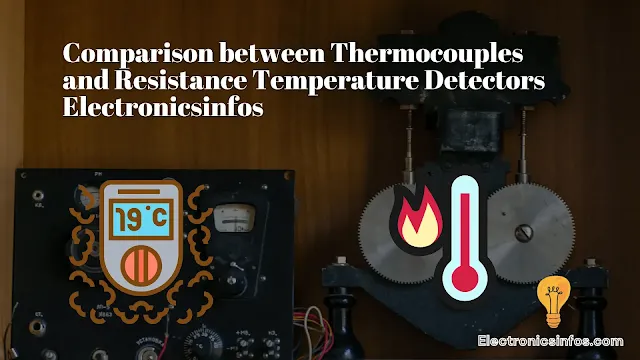Comparison Between Thermocouples and Resistance Temperature Detectors 2024
What are Thermocouples?
Thermocouples are temperature sensors that are widely used to measure temperature in various applications. They operate based on the principle of the Seebeck effect.
It states that when two dissimilar metals are joined at two junctions and there is a temperature gradient across the junctions, a voltage is generated that is proportional to the temperature difference.
Types of Thermocouples
- Type K (Chromel-Alumel) : -200°C to +1260°C
- Type J (Iron-Constantan) : -40°C to +750°C
- Type T (Copper-Constantan): -200°C to +350°C
- Type E (Chromel-Constantan): -200°C to +900°C
- Type N (Nicrosil-Nisil) : -200°C to +1300°C
- Type S (Platinum-Rhodium) : 0°C to +1450°C
- Type R (Platinum-Rhodium) : 0°C to +1450°C
- Type B (Platinum-Rhodium) : 0°C to +1700°C
- Type C (Tungsten-Rhenium) : 0°C to +2315°C
- Type M (Nickel-Molybdenum/Nickel-Cobalt) : 0°C to +1400°C
Thermocouples
- Thermocouples operate based on the principle of the Seebeck effect, where a voltage is generated when two dissimilar metals are joined at two different temperatures. The voltage produced is proportional to the temperature difference.
- Thermocouples can measure a wide range of temperatures, from very low (cryogenic) to very high temperatures (up to 2300°C or higher, depending on the thermocouple type).
- Thermocouples have a relatively fast response time and can quickly detect temperature changes.
- Thermocouples offer good accuracy over a wide temperature range. The accuracy can vary depending on the thermocouple type, with some high-precision thermocouples offering better accuracy.
- Thermocouples have a nonlinear voltage-temperature relationship. They require linearization techniques or compensation tables to convert the voltage output into temperature readings.
- Thermocouples are generally less expensive compared to RTDs, making them a cost-effective option for many applications.
- Thermocouples are rugged and can withstand harsh environments, vibrations, and high-pressure conditions. They are commonly used in industrial applications.
- Thermocouples do not require an external power source for operation. The temperature difference between the two junctions generates the voltage signal.
What are Resistance Temperature Detectors(RTD)?
Resistance Temperature Detectors (RTDs) are temperature sensors. it measures temperature by correlating the resistance of the RTD element with temperature. As the temperature changes, the resistance of the RTD changes. This relationship is used to measure temperature accurately.
Types of RTDs
- Thin Film RTDs
- Wire-Wound RTDs
- Coiled Elements RTDs
Resistance Temperature Detectors (RTDs)
- RTDs work on the principle of the relationship between electrical resistance and temperature. RTDs use a sensing element made of pure metal (such as platinum) with a known and predictable resistance-temperature relationship.
- RTDs can measure temperatures ranging from -200°C to about 850°C, depending on the materials used and the application.
- RTDs have a slower response time compared to thermocouples. They require more time to stabilize and accurately reflect the temperature changes.
- RTDs offer high accuracy and repeatability, making them suitable for precise temperature measurements.
- RTDs have a linear resistance-temperature relationship, which simplifies the conversion from resistance to temperature. They do not require nonlinear compensation like thermocouples.
- RTDs are generally more expensive than thermocouples due to the higher cost of the sensing element material (e.g., platinum).
- RTDs have a higher sensitivity compared to thermocouples, resulting in better resolution and precision.
- RTDs require an external power source, typically a low-level DC current, to measure the resistance accurately.
- RTDs may require periodic calibration to maintain accuracy. They can drift over time, and calibration ensures their continued reliability.
Conclusion
Thermocouples and RTDs each have their strengths and limitations. The choice between the two should be guided by the specific requirements of your application.
Frequently Asked Questions – FAQs
What is the main difference between thermocouples and RTDs?
- Thermocouples Measure temperature based on the voltage generated at the junction of two different metals.
- RTDs Measure temperature based on the change in electrical resistance of a metal with temperature.
Which sensor is more accurate, thermocouples or RTDs?
RTDs are generally more accurate and provide better stability.
What temperature ranges can thermocouples and RTDs measure?
- Thermocouples Can measure from -200°C to +2500°C.
- RTDs Typically measure from -200°C to +850°C
Do RTDs require special signal conditioning?
Yes, RTDs require current excitation and signal conditioning.
Are thermocouples cheaper than RTDs?
Yes, thermocouples are generally less expensive than RTDs.
Which industries prefer thermocouples?
Thermocouples are preferred in industries such as metal processing, power generation, and aerospace.
Which industries prefer RTDs?
RTDs are favoured in industries like pharmaceuticals, food and beverage.
Related Posts


.png)

-Electronicsinfos.png)

0 Comments
please do not insert spam links